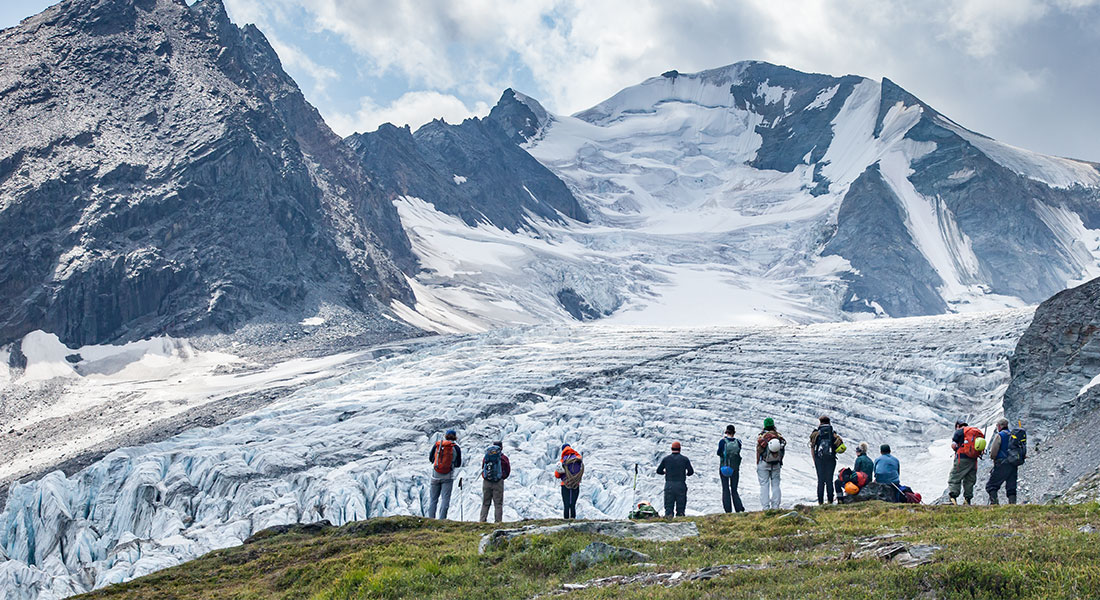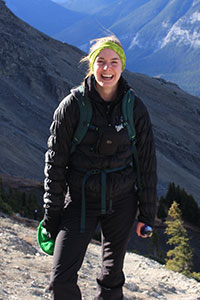
Mountains 101 is a Massive Open Online Course (MOOC) teaching a comprehensive overview of mountain studies in Alberta, Canada, and around the world. For more information, visit uab.ca/mountains101.
Laura is an MSc student studying in the Department of Biological Sciences at the University of Alberta under Dr. Rolf Vinebrooke. Her research interests focus on alpine limnology and ecological adaptations in response to a changing climate. She is a recent recipient of an NSERC Canadian Graduate Scholarship (CGS-M).
What attracted you the University of Alberta?
I did my undergraduate degree in biology at Queen's University. I worked in a number of labs, mostly doing aquatic research involving both field and lab work. After my third year, I worked as a field assistant for a project that looked at the range limits of an annual plant, called yellow rattle, in Kananaskis Country. That summer, I fell in love with the mountains and became more interested in research involving extreme environments and how these extremes are affected by our changing climate. At an open house talk at the Barrier Lake Field Station, I learned about the work of the Vinebrooke Lab at U of A. This research combined my interests in both limnology and mountain studies. The University of Alberta is a renowned research institution, and being able to study what I love here really makes it a perfect match.
What is your area of research? What is the question you are hoping to answer?
I am an alpine limnologist, and my research explores the factors that determine the community composition of zooplankton in the Canadian Rocky Mountains. Concern is increasing over the potential negative impacts of climate change on lakes and ponds, and alpine systems are especially susceptible to such changes. By understanding the distribution of species and the abiotic and biotic factors that contribute, we can gain insights and improve forecasts of ecological impacts of global warming. Alpine freshwater lakes and ponds have relatively simple biological communities that can be observed within a single season and act as an early warning indicator of broader changes occurring in mountain environments. With this new knowledge, it will be possible to identify vulnerable alpine pond and lake systems and initiate policy and management procedures to conserve these valuable ecosystems.
Techtips
- How to dress for the mountains
- Layers are key-in colder weather, add more layers
- Start with a wicking layer for moisture transport
- The next layer is your insulating layer for warmth
- Your outermost layer is your weather protection
- What goes in a pack?
- Food and hydration
- Sun protection including high SPF sunscreen, a full coverage sunhat and sunglasses
- Multi-tool, such as a pocket knife
- Blister kit
- Navigation kit, including map and compass
- Layers for changing weather
- Warm gloves and hat
- First aid kit
- Communication tool (cell phone or satellite phone)
- Bear spray
- How to plan a trip
- Consult your guidebook for insight into how extensive your trip will be
- Learn the basics of map reading: topography, ground cover, contour lines
- Calculate the trip home, keeping in mind both distance and elevation gain
- Pack accordingly
- Stay safe
- For glacier travel, falling in is the biggest risk
- To prevent falling, travel together attached to a rope at even intervals of 10-12 meters
- Bring other tools for snow and ice travel, like crampons and an ice axe
- Anchors increase safety margins with ice screws or rock climbing hardware
- Understand the risks and get the right training before heading into higher-risk terrain
- Environmental ethics
- Respect all living things: do not approach or feed wildlife
- Pack it in pack it out: take home what you bring to the mountains, including all litter and waste
- Stick to hard, durable surfaces to protect fragile vegetation in the alpine
- Take only photos, leave only footprints
- Be fire-wise: use a canister camp stove instead of an open flame
- "A thing is right when it tends to preserve the integrity, stability, and beauty of the biotic community. It is wrong when it tends otherwise" - Aldo Leopold
What is about the mountains that have such enduring appeal for so many Albertans, Canadians, people in general?
The mountains create a sense of curiosity and wonder. When you look out at the expanse of peaks, it's hard not to imagine the dynamic changes that have occurred over a period of time we can't even comprehend. In the Canadian Rockies, the vast untamed wilderness has such an enduring appeal for people. It is one of the few true wild places in the world remaining, where people of all ages can connect with nature. The adventures are truly endless. There is something for everyone in the mountains, and everyone has their own personal connection that makes the mountains special to them.
How did you come to be involved in Mountains 101?
Since moving to Edmonton last July, I have become involved in the mountains studies program at U of A in a number of ways. I first took the mountain backcountry field course last August and was introduced to Zac Robinson [a professor in Physical Education and Recreation who focuses on the cultural and social histories of the Rocky and Columbia Mountains] and David Hik [a professor in Biological Sciences whose research emphasizes plant-herbivore-climate connections in northern alpine and tundra ecosystems]. I was also a teaching assistant for the Introduction to Interdisciplinary Mountain Studies this past winter, where I taught a lecture on Alpine Limnology. From there, the mountain world really opened up to me, and Mountains 101 is allowing me to share my passion for the mountains with a broader audience, from mountain ranges all across the world.
What is your role in Mountains 101? What is the information you are sharing through "TechTips"?
TechTips are a series of general tips and tricks to keep in mind when heading out into the mountains that Matt Peter (degree?) and I will present at the end of each Mountains 101 lesson. They range from what to wear and what to bring to techniques to safely navigate the mountains. We really want to encourage people to get out into the mountains to have a first-hand look at what they will be learning in Mountains 101. We hope these tips will allow people to do so safely and with a little more confidence in their abilities, while simultaneously reducing their environmental impact. Mountains do not often offer the easiest terrain, but that shouldn't discourage people from enjoying all the beauty and adventure they have to offer.
What is your top tip for mountaineering?
My top tip for mountain travel is to be prepared. In the mountains, you have to be prepared for anything that Mother Nature throws at you-inclement weather, run-ins with wildlife, and unexpected injuries, to name a few. Understanding your risk and being prepared for it is the best way to enjoy the mountains. Having the correct gear, knowing your route, and packing accordingly are all key things to think about before trekking into mountain terrain. In TechTips, we will work towards preparing you for your own mountain adventures!
